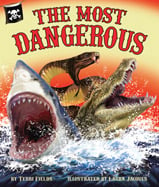Alignment to Standards for TN

| Grade | Number | Standard |
|---|---|---|
| 1 | SC-1.1.2. | Recognize that smaller parts of living things contribute to the operation and well being of entire organisms. |
| 1 | SC-1.2.3. | Examine interrelationships among plants, animals, and their environment. |
| 1 | SC-1.5.2. | Recognize that living things have features that help them to survive in different environments. |
| 1 | SS-1.2.03.b | Differentiate between consumers and producers. |
| 1 | SS-1.3.01. | Understand how to use maps, globes, and other geographic representations, tools, and technologies to acquire, process and report information from a spatial perspective. |
| 1 | SS-1.3.01.a | maps and globes are representations or models of specific places. |
| 1 | SS-1.3.01.d | Interpret symbols that represent various forms of geographic data and use these symbols to identify locations and directions. |
| 1 | SS-1.3.02. | Recognize how to identify and locate major physical and political features on maps and globes. |
| 1 | SS-1.3.02.c | Locate cities, states, countries, and continents on maps and globes and major bodies of water on maps and globes. |
| 2 | SC-2.5.2. | Recognize that living things have features that help them to survive in different environments. |
| 2 | SS-2.3.01. | Understand how to use maps, globes, and other geographic representations, tools, and technologies to acquire, process and report information from a spatial perspective. |
| 2 | SS-2.3.01.d | Recognize that a map contains elements such as title, scale, symbols, legends, grids, cardinal and intermediate direction. |
| 2 | SS-2.3.03. | locate major physical and political features on globes and maps. |
| 2 | SS-2.3.03.a | Show how landmasses and bodies of water are represented on maps and globes. |
| 3 | SC-3.2.3. | Examine interrelationships among plants, animals, and their environment. |
| 3 | SC-3.5.2. | Recognize that living things have features that help them to survive in different environments. |
| 3 | SS-3.3.01. | Understand how to use maps, globes, and other geographic representations, tools, and technologies to acquire, process and report information from a spatial perspective. |
| 3 | SS-3.3.02.d | Describe how environments and regions differ around the world. |
| 3 | SS-3.3.03. | Demonstrate how to identify and locate major physical and political features on globes and maps. |
| 4 | SC-4.3.2. | Recognize the function of specific structures in organisms that allow them to obtain and use energy. |
| 4 | SC-4.5.1. | Realize that plants and animals can be grouped according to similarities and differences in their characteristics. |
| 4 | SC-4.5.1.a | Classify animals, by type, according to their characteristics. |
| 5 | SC-5.2.1.a | Classify specific kinds of relationships among plants and animals within an ecosystem. |
| 5 | SC-5.4.1. | Realize that certain characteristics are passed from parents to offspring. |
| 5 | SC-5.5.1. | Realize that plants and animals can be grouped according to similarities and differences in their characteristics. |
| K | SC-K.5.2. | Recognize that living things have features that help them to survive in different environments. |
| K | SC-K.5.2.a | Know that different organisms tend to be found in different environments. |
| K | SS-K.3.01. | Understand how to use maps, globes, and other geographic representations, tools, and technologies to acquire, process and report information from a spatial perspective. |
| K | SS-K.3.01.a | Explain what a globe and map represent. |
| K | SS-K.3.03. | Demonstrate how to identify and locate major physical and political features on globes and maps. |